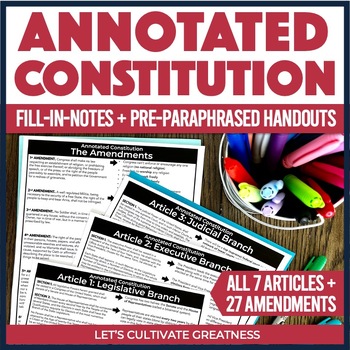7 Articles of the US Constitution, Bill of Rights & Amendments Simplified Notes
- PDF
- Google Apps™

Also included in
- Transform your high school Civics class with this inquiry-driven and project-based complete done-for-you semester course.Whether you're new to Civics or looking to upgrade to something powerful, this course will cultivate intrigue and skills in your students to be informed and engaged change-makers.Price $159.97Original Price $201.80Save $41.83
Description
Confidently guide students through the US Constitution's text so they can see for themselves their rights and the powers of the US government.
This annotated Constitution includes both the entirety of the original Constitution plus all 27 amendments:
- Article 1 -- the Legislative Branch
- Article 2 -- the Executive Branch
- Article 3 -- the Judicial Branch
- Articles 4-7 -- Federalism, State Rights, & Supremacy
- Amendments 1-10 -- the Bill of Rights
- Amendments 11-27
Use this as an alternative or supplement to your lectures or textbook reading.
This kit includes two options:
- Fill-in notes to use as a class activity
- Pre-filled to use as a reference handout
Greatness is being a well-informed and engaged constituent.
The Constitution has so many paradoxes: it solidified enslavement yet spoke of fairness and individual rights; it promotes democracy yet contains elements that seem counter that ideal; it's a relatively brief document yet has been the right mix of specific and flexible to outlast civil war and assassinations.
No American Civics and Government course is complete without framing it around THE central document.
But all the legalese and over 200 years of case law have overcomplicated the "so, what does that clause mean?"
This kit simplifies each Article and Amendment clause-by-clause in short 9th-grade-reading-level paraphrases.
This resource is essential as both a quick reference for you and the foundation for the content in your units.
Included in this complete annotated US Constitution kit:
- Teacher Overview -- detailed ideas for how to use in your classroom and links to legal expert sites that dive even further into legal interpretations
- Fill-in Guided Notes -- assist students in reading, clause-by-clause, the Constitution and paraphrasing what's said themselves
- Pre-filled Reference Notes -- two-column, already-paraphrased text written at an accessible middle/high school level
Both note sets divide the Constitution into each Article so you can hand out just the section you're currently covering. For example, Article 2, as you cover the Executive Branch.
How to Use in Your Classroom
- Kick off each unit by closely reading what the Constitution says
- Refer any in-class questions student have to their copy of the Constitution
- Review for unit tests, EOC exams, and practice Citizenship tests
- Differentiate to meet student needs with two versions
- Provide alternative to textbook reading or lecture
Note: In order to be most useful to you and your students as a quick reference tool, this resource comes in uneditable PDF format only.
Standards Supported While standards vary, this kit supports the following from various states:
- Understands the importance of a written constitution
- Analyze the structure and functions of the legislative, executive, and judicial branches of government
- Explains how provisions in the US Constitution provide for checks and balances among the three branches
- Identifies the freedoms and rights protected by the Bill of Rights
- Identifies how citizenship and voting rights have expanded over time (13th, 14th, 15th, 17th, 19th, 23rd, 24th, and 26th Amendments)
Want more ways to deliver Civics content?
Brand new to teaching Civics / Government and need everything?
Civics & American Government course bundle teach this inquiry-driven and project-based semester course with confidence
This listing is for one license for regular, non-commercial classroom use by a single teacher only. Commercial use like online teaching (ex. Outschool) or sharing with other teachers (ex. shared drive, in a Facebook group, in a professional development training) is strictly prohibited.
By purchasing a license to this resource, you have access to all future updates at no cost, available under “My Purchases." Multiple and transferable licenses are available for purchase. PDF files are uneditable, other files have editing abilities, unless otherwise stated. All files are protected under federal copyright laws.
To request a complete terms of use prior to purchase or if you have any questions about this resource, please leave a question below under Product Q&A.






